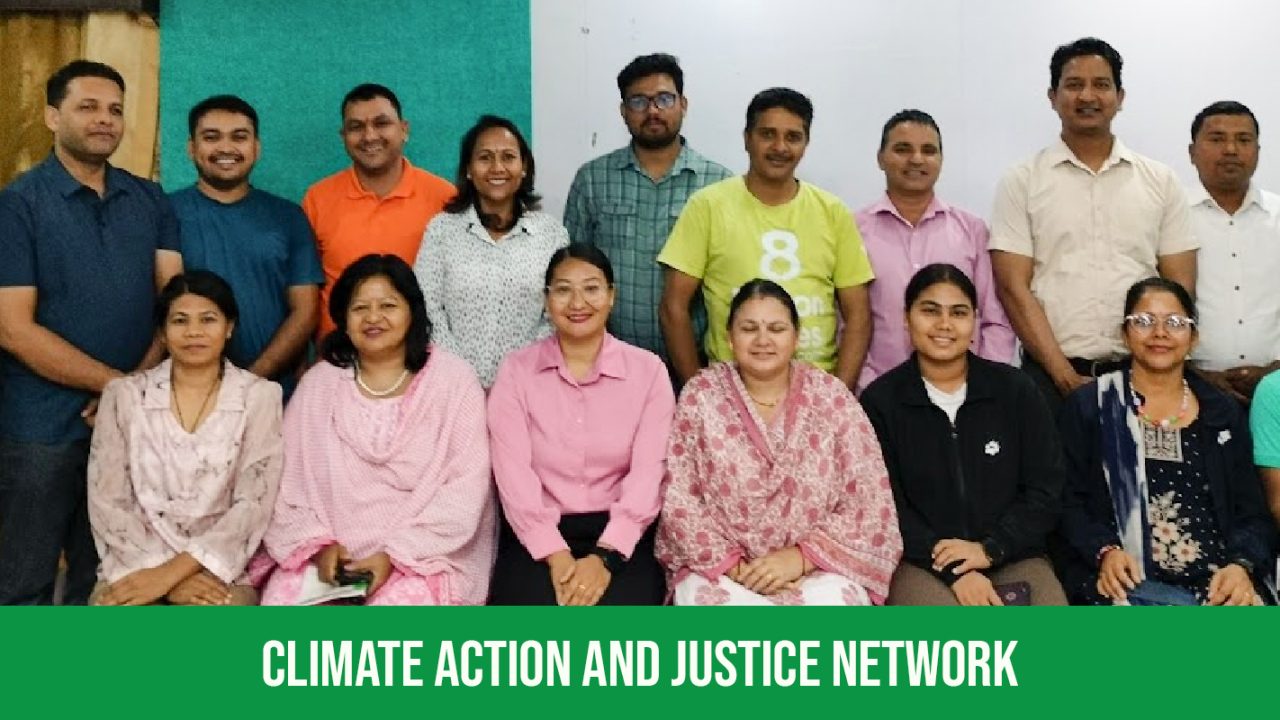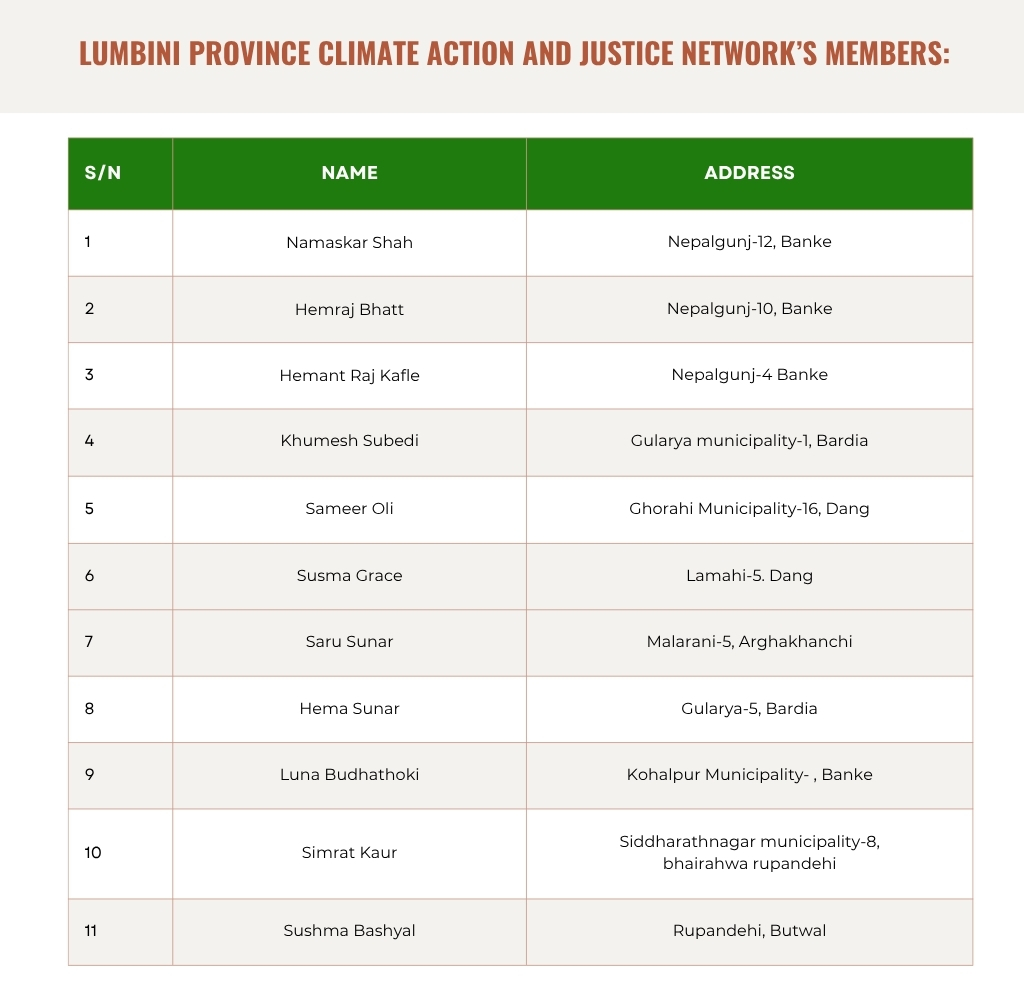

The Climate Action and Justice Network (CAJ-Network) is a pioneering initiative spearheaded by CLEAN UP NEPAL to address pressing environmental and climate-related issues in Nepal. As the country faces escalating challenges from pollution, deforestation, unsustainable waste management, and the impacts of climate change, there is a critical need for cohesive and coordinated action. The network was formed to serve as a robust platform for advocacy, policy dialogue, and collaboration among diverse stakeholders, including civil society organizations, youth groups, government entities, and communities.
The CAJ-Network aims to strengthen advocacy efforts for climate action, environmental protection, clean air, and justice in Nepal by influencing policy and practice at all levels of government. Recognizing the importance of Article 30 of the Constitution of Nepal [Right to clean environment: (1) Every citizen shall have the right to live in a clean and healthy environment. (2) The victim shall have the right to obtain compensation, in accordance with law, for any injury caused from environmental pollution or degradation], which guarantees the right to a clean and healthy environment, the network seeks to ensure that environmental human rights are upheld and that citizens’ voices are amplified in the policy-making process. By establishing provincial chapters across Nepal, CAJ-Network envisions a united front capable of pushing for systemic changes that benefit both people and the planet.
Objectives of Climate Action and Justice Network
To uphold and advocate for environmental human rights as enshrined in the Constitution of Nepal, particularly Article 30, which ensures every citizen’s right to live in a healthy environment. The network will push for stronger legislative frameworks and their implementation to safeguard these rights.
To actively engage with local, provincial, and national governments to influence the formulation, amendment, and enforcement of policies, acts, and regulations related to climate action, environmental protection, waste management, and clean air. This includes working towards stricter regulations, better enforcement mechanisms, and increased budget allocations for environmental initiatives.
To advocate for equitable climate action by ensuring that marginalized and vulnerable communities are considered in climate adaptation and mitigation plans. This includes highlighting climate injustices, promoting inclusive decision-making, and ensuring access to climate resilience resources for all.
To establish and operationalize provincial chapters of the Climate Action and Justice Network across Nepal. These chapters will drive localized advocacy, engage with local stakeholders, and ensure that regional environmental issues are brought to national attention, creating a comprehensive and unified advocacy network.
To conduct awareness campaigns, workshops, and capacity-building programs for different community groups, including youth, women, and marginalized communities, to enhance their understanding of climate issues, environmental rights, and the importance of sustainable practices. The network will also mobilize public support for climate and environmental advocacy through grassroots movements.
To build strategic partnerships with civil society organizations, academic institutions, media, private sector entities, and international organizations to strengthen collective efforts for climate action and environmental justice. This involves knowledge sharing, joint campaigns, and coordinated advocacy efforts to amplify impact.
- To monitor the implementation of environmental laws and policies and hold relevant stakeholders accountable. The network will use evidence-based research, data collection, and community feedback to advocate for better governance, transparency, and accountability in environmental management.
Major Activities of CAJ-Network
1. Policy Advocacy and Lobbying:
- Organize regular advocacy meetings, workshops, and dialogues with policymakers, including provincial and national parliamentarians, government officials, and relevant ministries, to influence and strengthen climate and environmental policies.
- Draft policy briefs, position papers, and recommendations on climate action, waste management, clean air, and environmental justice for submission to government bodies and other stakeholders.
- Engage in lobbying efforts to push for legislative reforms and better implementation of existing laws related to environmental protection, climate change adaptation and mitigation, and waste management.
2. Provincial-Level Advocacy Forums:
- Establish and operationalize CAJ-Network provincial chapters in all provinces of Nepal. Each chapter will serve as a hub for local advocacy, stakeholder engagement, and grassroots mobilization.
- Conduct provincial-level advocacy forums to identify region-specific environmental challenges and formulate targeted action plans. These forums will also serve as platforms for provincial chapters to share best practices and coordinate on national advocacy efforts.
3. Public Awareness and Education Campaigns:
- Develop and implement public awareness campaigns on climate change, environmental rights, clean air, and sustainable waste management practices. Utilize various channels such as social media, local radio, community theater, and print media to reach diverse audiences.
- Organize educational workshops, seminars, and training sessions for schools, universities, community groups, and local leaders to raise awareness about environmental issues and the importance of climate justice.
4. Climate Justice and Environmental Human Rights Advocacy:
- Conduct research and publish reports on the impacts of climate change, pollution, and environmental degradation on marginalized and vulnerable communities in Nepal. Use these findings to advocate for climate justice and equity-focused policy interventions.
- Collaborate with human rights organizations to monitor and report violations of environmental rights and to advocate for the protection of communities affected by environmental injustices.
5. Capacity Building and Training Programs:
- Develop capacity-building programs for network members, civil society organizations, and community leaders to enhance their skills in advocacy, policy analysis, public speaking, and strategic campaigning.
- Provide training on waste management practices, climate adaptation, and mitigation techniques for local governments, community-based organizations, and youth groups to build local resilience and promote sustainable practices.
6. Collaborative Research and Knowledge Sharing:
- Conduct collaborative research on climate change impacts, environmental policies, waste management strategies, and air quality issues in Nepal. Publish findings in accessible formats to inform advocacy efforts and public discourse.
- Organize knowledge-sharing events, such as conferences, roundtable discussions, and webinars, to bring together stakeholders from academia, government, civil society, and the private sector for dialogue and learning.
7. Grassroots Mobilization and Campaigns:
- Mobilize communities, youth groups, and civil society organizations to participate in grassroots campaigns and movements aimed at demanding stronger climate and environmental policies and actions. This may include petitions, peaceful demonstrations, and community-based actions.
- Launch nationwide campaigns, such as "Clean Air for All" to build public pressure on decision-makers to prioritize environmental and climate issues.
8. Strategic Partnerships and Networking:
- Build and strengthen strategic partnerships with national and international organizations, academic institutions, donor agencies, and private sector entities to enhance the network's advocacy efforts and resource mobilization.
- Actively participate in national, regional, and global climate and environmental forums, networks, and coalitions to represent Nepal's perspective and collaborate on shared objectives.
9. Monitoring and Accountability Initiatives:
- Establish mechanisms for monitoring the implementation of environmental policies and commitments made by government and private sector actors. This may include community monitoring, citizen reporting tools, and public scorecards.
- Conduct audits and assessments of government programs related to climate action and waste management to ensure transparency, accountability, and effective use of resources.
10. Development of Resource and Information Hubs:
- Create an online resource center to provide information on climate policies, environmental laws, best practices, and tools for advocacy and awareness-raising. This platform will serve as a knowledge base for stakeholders and the general public.
- Publish newsletters, reports, and case studies to share updates on CAJ-Network activities, achievements, and ongoing advocacy efforts.
11. Capacity Enhancement for Media Advocacy:
- Organize training sessions for journalists and media professionals on climate change reporting, environmental justice, and advocacy to ensure accurate and impactful coverage of environmental issues in Nepal.
- Develop media toolkits and resources to support effective communication and storytelling around climate and environmental justice issues.

